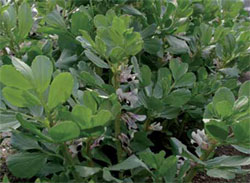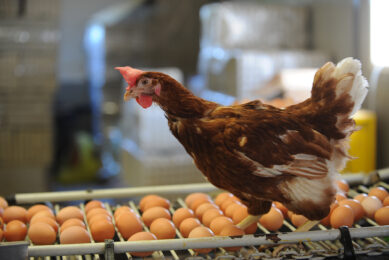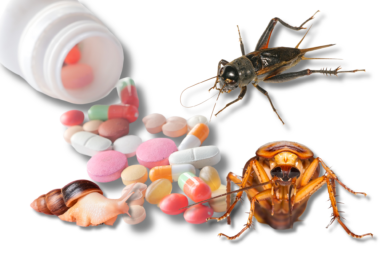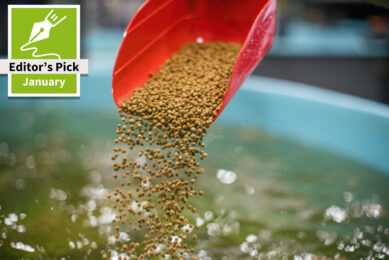Faba beans: An alternative protein source for animals

The increased demand for vegetable based protein sources both locally and internationally has resulted in an increased research focus on alternative plant protein sources. Historically, the use of faba beans in animal feeds has been limited due to the presence of antinutritional factors (ANF). However, recent advances in plant breeding have helped to reduce the presence of ANFs, while advances in animal feed processing technology and the use of feed additives (such as exogenousenzymes) means that the presence of certain ANFs can be more effectively managed.
The Grain Legumes Project (GLP), a project jointly funded by the Foundation for Arable Research (FAR), the New Zealand Feed Manufacturers Association (NZFMA) and the MAF Sustainable Farming Fund (SFF) was initiated in 2003/04 to examine the potential for the use of grain legumes as alternative protein sources for inclusion in animal feeds in New Zealand.
A range of nutrient values has been reported for faba beans (Vicia faba, broad beans) and some of the values reported are shown in Table 1. Comparative values for soybean meal are also included.
Although faba beans are a good source of crude protein, they are low in the sulphur-containing amino acids such as methionine and cysteine. The amino acid profile will limit inclusion of faba beans in high density diets. In addition, the availability of amino acids is influenced by the presence of ANFs so there may be considerable variation between cultivars.
Antinutritional factors
Tannins present in the seed coat of faba beans have a negative impact on the availability of both amino acids and energy in monogastric diets. However, the problem is readily addressed by dehulling. In addition, tannin-free genotypes are now relatively easy to obtain. The presence of the glycosides, vicine and convicine (VC) are known to affect the metabolism of laying hens, but appear to have limited effect on broilers, pigs or ruminants. The discovery of a gene which can reduce the VC content by 90-95% means that low VC cultivars are now available on the market. The trypsin inhibitor activity in faba beans is not well documented but appears to be low. Recent work carried out around the world has shown that modern faba bean cultivars can be successfully included in both monogastric (e.g. pig and poultry) and ruminant (e.g. beef, dairy, sheep and goat) feeds. Some of the results of recently reported work are summarised in the following paragraphs.
Animals digest faba beans differently
Recent work carried out in New Zealand (Ravindran et al., 2007) showed that when diets are formulated on the basis of metabolisable energy and ileal digestible amino acids, faba beans can be used successfully in broiler diets up to levels of 20%. Similar results were reported by Farrell et al. (1999) while Crépon et al. (2004) reported that levels of up to 25% could be used in broiler diets.
Layer hens are more sensitive to the presence of VC in faba beans, with reduced egg size and feed intake commonly reported for birds fed diets containing faba beans. Perez-Maldonado et al. (1999) reported that the inclusion of faba beans at levels of 25% in laying hen diets in Australia resulted in reduced performance. In 2003, researchers working with low-VC faba beans in Germany reported that faba beans with 0.69% VC could be used without negative effects on egg production and feed intake at levels of up to 30% in laying hen diets (Dänner, 2003). More recently German researchers (Fru-Nji et al., 2007) concluded that faba beans (with a VC content of 0.88%) could be included in layer hen diet at levels of up to 16% without a significant reduction in production or egg quality.
Canadian researchers (Lopetinsky et al., 2004) concluded that zero-tannin faba beans could be included at rates of up to 30% in pig diets without a negative effect on feed intake. These authors reported that average daily gain across the entire experimental period was not significantly different between pigs fed soybean meal or faba beans. However, barrows fed soybean meal in the grower phase had a significantly greater average daily gain and feed conversion ratio than those fed faba beans. The authors hypothesised that this may have been a result of an overestimation of the digestible amino acid or net energy content of the faba beans.
Yu et al. (2000) reported that rapid and extensive ruminal degradation of faba beans makes them unsuitable and/or inefficient for use in an unprocessed form. These authors found that pressure toasting of faba beans was an effective way of reducing ruminal protein degradation. In contrast, Matthews and Marcellos (2003) reported that faba beans can be used in dairy rations at inclusion levels of up to 35%. However, these authors did not state whether or not processing of the beans would improve their nutritional value.
Valuing faba beans in commercial diets
As with any raw material, the relative value of faba beans in commercial diets will depend on a range of factors such as the nutrient content of the raw material itself, the cost of the raw material and the relative value of other available raw materials. Consequently, each raw material will have a different relative value for each feed and each feed manufacturer. Individual feed manufacturers must therefore make their own decision on whether or not any given raw material, at any given price, will prove cost effective in their feed formulations, given the range of products they produce. This can easily be done using the parametric evaluation features available in standard commercial feed formulation software.
In addition, the use of technologies such as Multi-MixSRTm(from Format International) will allow nutritionist and feed manufactures to determine the relative value of a raw material across their entire product range. A parametric evaluation was carried out using WinFeedSRTm(EFG Software) in order to estimate the relative value of faba beans in poultry and pig diets commonly used in New Zealand. To illustrate the effect of price changes on the relative value of a raw material, two raw material price sets (from the December 2006 and 2007 editions of Pork Outlook) were used for this example. Raw materials and prices used in the parametric evaluation are shown in Table 2.Nutrient specifications for faba beans were those reported by the CVB (Novus Compendium, 1995). The maximum inclusion levels for faba beans were set at 15% for layer feeds, 20% for all broiler, pig grower, finisher and lactating sow diets, with a maximum inclusion level of 30% set for dry sow and boar diets.
The relative value of faba beans in each of the diets evaluated is shown in Table 3. Values were rounded to the nearest NZ$5. The estimated relative value of faba beans ranged from NZ$440/t (broiler starter) to NZ$490/t (dry sow and boar) for the 2007 cost set.
With high raw material prices, the value of faba beans is increased. However, in order for faba beans to be attractive in the more nutrient dense diets (e.g. broiler diets) a good energy source maybe required (e.g. maize or oil). The effect of the use of exogenous enzymes in the diet was not considered in this example but should be evaluated by individual feed manufacturers.
Regardless of the value of faba beans to individual feed manufacturers, market values and availability will play a key role in determining whether or not faba beans are used in commercial livestock feeds.
This article was adapted from the New Zealand Feed Manufacturers Association’s autumn 2008 newsletter.
1 NZ$ = 0.51 US$ = 0.40 € (Feb 2009)











